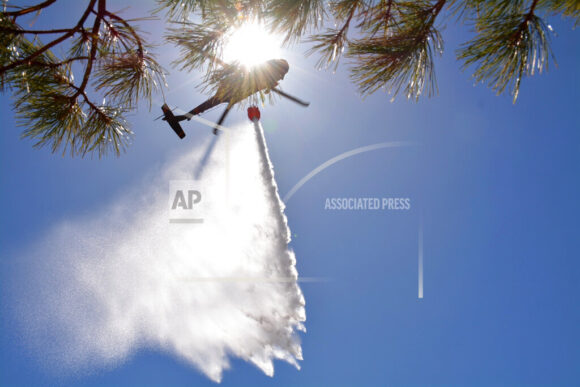ALBUQUERQUE, N.M. (AP) — Wind-whipped flames raced Monday across more of New Mexico’s tinder-dry mountainsides, after forcing more residents to flee their homes while firefighting crews elsewhere in the drought-parched state tried to prevent new wildfires from growing.
The blaze burning near the community of Las Vegas in northeastern New Mexico is the biggest wildfire in the U.S. and has charred more than 188 square miles (487 square kilometers). Fire officials said they expect it to keep growing.
“Winds are changing constantly and those, combined with low humidity and high temperatures keep the fire spreading at dangerous speeds and in different directions,” fire officials warned in an overnight update about the fire. “Over the next two weeks, the majority of our days are listed as red flag days, with high winds, which will continue to make suppression efforts difficult.”
The fire has been fanned by an extended period of hot, dry and windy conditions and ballooned in size Sunday, prompting authorities to issue new evacuation orders for parts of Las Vegas, population about 13,000, the small town of Mora and other villages.
Officials have said the fire has damaged or destroyed 172 homes and at least 116 structures. It merged last week with another blaze that was sparked in early April when a prescribed fire set by fire firefighters to clear brush and small trees that can serve as fire fuel escaped containment. The cause of the other fire is still under investigation.
Another New Mexico wildfire burning in the mountains near Los Alamos National Laboratory also prompted more evacuations over the weekend. It has reached the burn scars of wildfires that blackened the region a decade ago when New Mexico had one of its worst and most destructive seasons on record.
Nearly 3,000 wildland firefighters are battling blazes around the U.S., with about one-third of those assigned to the largest fire burning in New Mexico.
The blazes are among many this spring that forced panicked residents to make life-or-death, fight-or-flee snap decisions as wildfire season heats up in the U.S. West. Years of hotter and drier weather have the exacerbated blazes, leading them to frequently burn larger areas and for longer periods compared with previous decades.
Wildfires have become a year-round threat in the West given changing conditions that include earlier snowmelt and rain coming later in the fall, scientist have said.
The problems have been exacerbated by decades of fire suppression and poor management along with a more than 20-year megadrought that studies link to human-caused climate change.
About the photo: In this photo provided by the New Mexico National Guard, New Mexico National Guard Aviation soldiers execute water drops as part of firefighting efforts, dropping thousands of gallons of water from a UH-60 Black Hawks with Bambi buckets on the Calf Canyon/Hermits Peak fire in northern New Mexico Sunday, May 1, 2022. Thousands of firefighters are battling destructive wildfires in the Southwest as more residents are preparing to evacuate. (New Mexico National Guard via AP)
Was this article valuable?
Here are more articles you may enjoy.


 Singer’s Elliott Sued by PE Firm in Escalating Fight Over Money
Singer’s Elliott Sued by PE Firm in Escalating Fight Over Money  Cyber Breach Affected 750,000 Canadian Investors, Regulator Says
Cyber Breach Affected 750,000 Canadian Investors, Regulator Says  Palantir Poaching Suit Called ‘Scare’ Tactic by Ex-Employees
Palantir Poaching Suit Called ‘Scare’ Tactic by Ex-Employees  Surging Oil Tanker Insurance Points to Growing Black Sea Chaos
Surging Oil Tanker Insurance Points to Growing Black Sea Chaos 